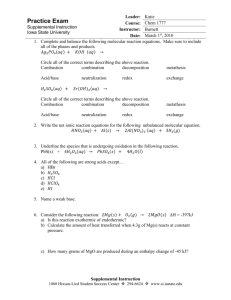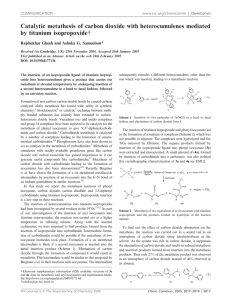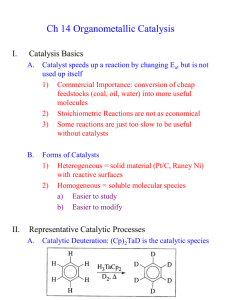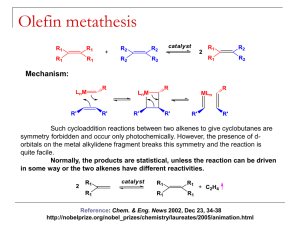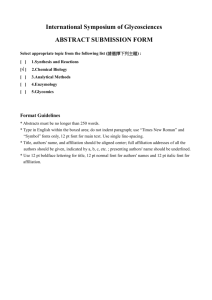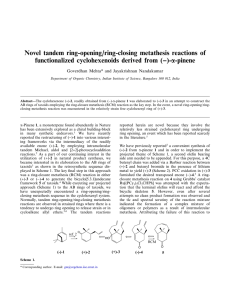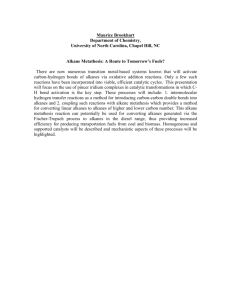Metathesis of carbon dioxide and phenyl isocyanate catalysed
advertisement
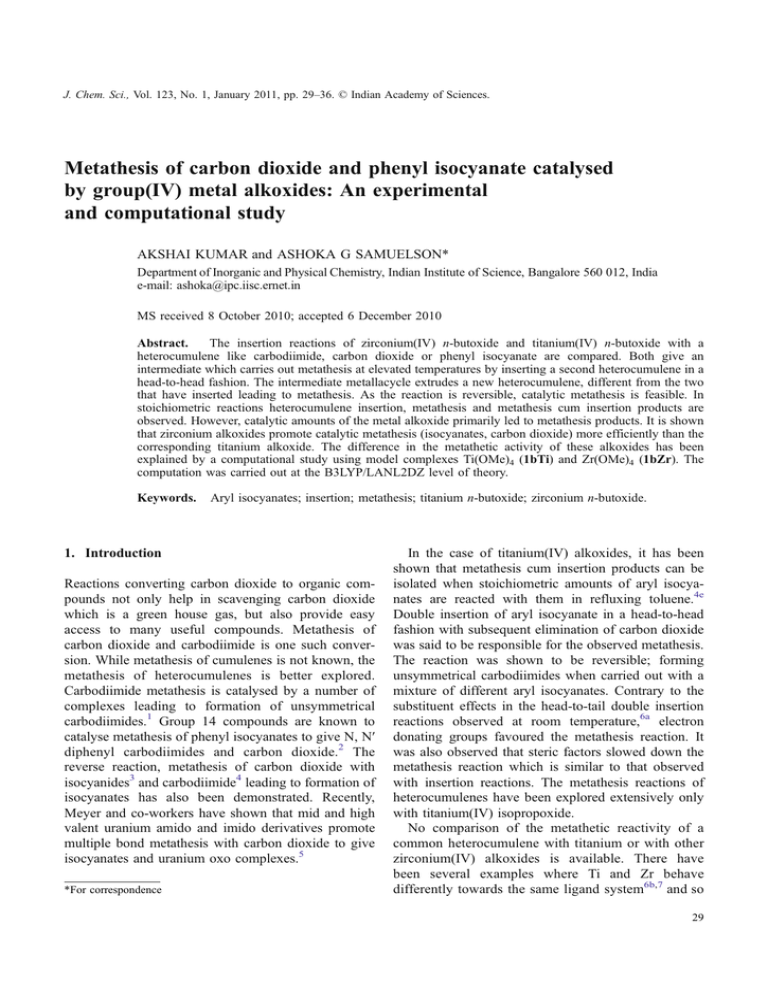
J. Chem. Sci., Vol. 123, No. 1, January 2011, pp. 29–36. * Indian Academy of Sciences.
Metathesis of carbon dioxide and phenyl isocyanate catalysed
by group(IV) metal alkoxides: An experimental
and computational study
AKSHAI KUMAR and ASHOKA G SAMUELSON*
Department of Inorganic and Physical Chemistry, Indian Institute of Science, Bangalore 560 012, India
e-mail: ashoka@ipc.iisc.ernet.in
MS received 8 October 2010; accepted 6 December 2010
Abstract.
The insertion reactions of zirconium(IV) n-butoxide and titanium(IV) n-butoxide with a
heterocumulene like carbodiimide, carbon dioxide or phenyl isocyanate are compared. Both give an
intermediate which carries out metathesis at elevated temperatures by inserting a second heterocumulene in a
head-to-head fashion. The intermediate metallacycle extrudes a new heterocumulene, different from the two
that have inserted leading to metathesis. As the reaction is reversible, catalytic metathesis is feasible. In
stoichiometric reactions heterocumulene insertion, metathesis and metathesis cum insertion products are
observed. However, catalytic amounts of the metal alkoxide primarily led to metathesis products. It is shown
that zirconium alkoxides promote catalytic metathesis (isocyanates, carbon dioxide) more efficiently than the
corresponding titanium alkoxide. The difference in the metathetic activity of these alkoxides has been
explained by a computational study using model complexes Ti(OMe)4 (1bTi) and Zr(OMe)4 (1bZr). The
computation was carried out at the B3LYP/LANL2DZ level of theory.
Keywords.
Aryl isocyanates; insertion; metathesis; titanium n-butoxide; zirconium n-butoxide.
1. Introduction
Reactions converting carbon dioxide to organic compounds not only help in scavenging carbon dioxide
which is a green house gas, but also provide easy
access to many useful compounds. Metathesis of
carbon dioxide and carbodiimide is one such conversion. While metathesis of cumulenes is not known, the
metathesis of heterocumulenes is better explored.
Carbodiimide metathesis is catalysed by a number of
complexes leading to formation of unsymmetrical
carbodiimides.1 Group 14 compounds are known to
catalyse metathesis of phenyl isocyanates to give N, N′
diphenyl carbodiimides and carbon dioxide.2 The
reverse reaction, metathesis of carbon dioxide with
isocyanides3 and carbodiimide4 leading to formation of
isocyanates has also been demonstrated. Recently,
Meyer and co-workers have shown that mid and high
valent uranium amido and imido derivatives promote
multiple bond metathesis with carbon dioxide to give
isocyanates and uranium oxo complexes.5
*For correspondence
In the case of titanium(IV) alkoxides, it has been
shown that metathesis cum insertion products can be
isolated when stoichiometric amounts of aryl isocyanates are reacted with them in refluxing toluene.4e
Double insertion of aryl isocyanate in a head-to-head
fashion with subsequent elimination of carbon dioxide
was said to be responsible for the observed metathesis.
The reaction was shown to be reversible; forming
unsymmetrical carbodiimides when carried out with a
mixture of different aryl isocyanates. Contrary to the
substituent effects in the head-to-tail double insertion
reactions observed at room temperature,6a electron
donating groups favoured the metathesis reaction. It
was also observed that steric factors slowed down the
metathesis reaction which is similar to that observed
with insertion reactions. The metathesis reactions of
heterocumulenes have been explored extensively only
with titanium(IV) isopropoxide.
No comparison of the metathetic reactivity of a
common heterocumulene with titanium or with other
zirconium(IV) alkoxides is available. There have
been several examples where Ti and Zr behave
differently towards the same ligand system6b,7 and so
29
30
Akshai Kumar and Ashoka G Samuelson
there is every possibility that different reactivity
would be exhibited by Zr towards metathesis. Hence
it would be interesting to know whether such
reactivity differences can be used to control the
metathesis reactivity and how a change in the
alkoxide from isopropoxide to butoxide affects metathesis. In this paper, we report the metathesis
reaction of phenyl isocyante (PhNCO) catalysed by
titanium(IV) n-butoxide and zirconium(IV) n-butoxide. There are distinct differences in the reactivity of
phenyl isocyante with group(IV) metal alkoxides at
room temperature and at elevated temperatures.
Computational studies performed on model complexes Ti(OMe) 4 and Zr(OMe)4 at the B3LYP/
LANL2DZ level of theory using the Gaussian 03
package, explain these differences very well.
2. Experimental
2.1 General
All manipulations were carried out under an inert
atmosphere of dry argon using a standard double
manifold. Toluene and tetrahydrofuran were freshly
distilled from sodium/benzophenone prior to use.
Zirconium(IV) n-butoxide (84 wt% in 1-butanol),
titanium(IV) n-butoxide, titanium(IV) isopropoxide
and phenyl isocyanate were procured from Aldrich
U.S.A. Zirconium(IV) n-butoxide solution was evaporated to dryness under vacuum at 110°C. Commercial grade carbon dioxide was obtained from
Bhuruka Gas India. It was dried by passing through
a column containing alternative layers of fused
calcium chloride and P2O5 prior to use. Diphenyl
carbodiimide was synthesized by the literature
procedure.8a
2.2 Physical measurements
1
H NMR, 13C{H} NMR, inverse gated decoupled 13C
NMR were recorded on Bruker AMX 400 operating at
400 MHz for 1H NMR and 100 MHz for 13C NMR,
with tetramethylsilane as internal reference. All spectra
were recorded in CDCl3.
2.3 General procedure for the metathesis of phenyl
isocyanate
To a solution of zirconium(IV) n-butoxide (0⋅134 g,
0⋅35 mmol) dissolved in 15 ml toluene, phenyl isocyanate (0⋅38 ml, 3⋅5 mmol) was added. The mixture was
stirred and refluxed for 48 h. The solvent was then
evaporated to dryness under vacuum. The mixture was
worked up by addition of a stoichiometric amount of
water to precipitate out ZrO2, followed by extraction of
the organic fraction with dichloromethane and removal
of the solvent from the organic fraction. The yield of
diphenyl carbodiimide was calculated by inverse gated
decoupled 13C NMR and 1H NMR using ferrocene as
an internal standard. The yield of diphenyl carbodiimide was further verified by isolating it as diphenyl
urea after hydrolysis.
The organic fraction obtained in the catalytic
metathesis reaction was run on preparative TLC plates
using hexane, toluene and ethyl acetate in the ratio
7:3:1 as eluent. Compound 2 separated out as diphenyl
urea in this method, while compound 4 was obtained in
the pure form and compounds 3 and 6 remained as a
mixture. This mixture was run on preparative TLC
plates using 1% ethyl acetate in petroleum ether as
eluent, where compounds 3 and 6 were obtained in the
pure form.
2.4 Compound 38b
Butyl N-phenylcarbamate: mp = 62–63⋅5°C. 1H NMR
(400 MHz) δ 7⋅37 (d, 2H, J = 8 Hz), δ 7⋅30 (t, 2H,
J = 8 Hz), δ 7⋅05 (t, 1H, J = 7⋅3 Hz), δ 6⋅63 (s, 1H, NH),
δ 4⋅17 (t, 2H, J = 6⋅7 Hz), δ 1⋅65 (m, 2H), δ1⋅42 (m,
2H), δ 0⋅95 (t, 3H, J = 7⋅3 Hz). 13C NMR (100 MHz)
δ153⋅78, δ 138⋅02, δ 129⋅10, δ 123⋅37, δ 118⋅63, δ
65⋅18, δ 31⋅02, δ 19⋅14, δ 13⋅30.
2.5 Compound 68c
Butyl 2,4-diphenylallophanate: mp = 64⋅5–65⋅5°C. 1H
NMR (400 MHz) δ 10⋅91 (s, 1H, NH), δ 7⋅53 (d, 2H,
J = 7⋅6 Hz), δ 7⋅41 (m, 3H), δ 7⋅31 (t, 2H, J = 7⋅6 Hz), δ
7⋅22 (d, 2H, J = 7⋅6 Hz), δ 7⋅09 (t, 1H, J = 7⋅6 Hz), δ
4⋅15 (t, 2H, J = 6⋅8 Hz), δ 1⋅48 (m, 2H), δ 1⋅18 (m, 2
H), δ 0⋅82 (t, 3H, J = 7⋅6 Hz). 13C NMR (100 MHz) δ
156⋅08, δ 151⋅58, δ 137⋅77, δ 137⋅10, δ 128⋅96, δ
128⋅70, δ 128⋅26, δ 123⋅96, δ 119⋅92, δ 67⋅22, δ 30⋅31,
δ 18⋅78, δ 13⋅47. HRMS: Found m/z=335⋅1356 (M +
Na) +, calcd. mass for C18H20N2O3Na is 335⋅1372.
2.6 Compound 2
N,N′ diphenyl carbodiimide: 1H NMR (100 MHz) δ
7⋅27 (t, 2H, J = 7⋅4 Hz), δ 7⋅14 (d, 2H, J = 7⋅4 Hz), δ
7⋅11 (t, 1H, J = 7⋅4 Hz).13C NMR (100 MHz) δ 138⋅47,
δ 135⋅21, δ 129⋅42, δ 125⋅53, δ 124⋅15.
Metathesis of carbon dioxide and phenyl isocyanate
2.7 Compound 4
Carbamimidic acid, N,N′-diphenyl;n-butyl ester: 1H
NMR (400 MHz) δ 7⋅30 (m, 5H), δ 7⋅03 (m, 5H), δ
5⋅83 (s, 1H, NH), δ 4⋅35 (t, 2H, J = 6⋅8 Hz), δ 1⋅79 (m,
2H), δ 1⋅48 (m, 2H), δ 0⋅97 (t, 3H, J = 7⋅2 Hz). 13C
NMR (100 MHz) δ 150⋅31, δ 129⋅78, δ 128⋅94,
δ123⋅06, δ120⋅39, δ 66⋅92, δ 30⋅84, δ19⋅40, δ13⋅93.
2.8 General procedure for reactions with carbon
dioxide
Into 6 ml toluene in a sealable vial flushed with
nitrogen, carbon dioxide from a gas burette was
condensed. A mixture of zirconium(IV) n-butoxide
(0⋅239 g, 0⋅6 mmol) and diphenyl carbodiimide
(0⋅118 g, 0⋅6 mmol) in 2 ml toluene was added while
maintaining the vial at liquid nitrogen temperature.
The vial was subsequently evacuated and sealed. The
sealed vial was heated in an oil bath maintained at
115°C for 48 h. The vial was cooled, broken open and
the reaction mixture evacuated to dryness under
vacuum. The mixture was then worked up by addition
of stoichiometric amount of water to precipitate out
ZrO2, followed by extraction of the organic fraction
with dichloromethane. The solvent was removed from
the organic fraction and the ratio of 3 and 4 in the
residue was determined by 1H NMR.
2.9 Computational details
For theoretical studies, Ti(OMe)4 and Zr(OMe)4 were
taken as model complexes in place of Ti(OnBu)4 and
Zr(OnBu)4 where bulky nBu groups are replaced by
Me groups for computational efficiency. All structures
were optimized using the DFT method (B3LYP/
LANL2DZ), based on Becke’s three-parameter functional.9 The LANL2DZ basis set uses the effective core
potentials (ECP) of Hay and Wadt.10 The nature of the
stationary points was characterized by vibrational
frequency calculations. The Gaussian 03 program
package was used for all calculations.11
3. Results and discussions
3.1 Metathesis with carbon dioxide
In an attempt to test the metathesis reaction of carbon
dioxide, equimolar amounts of diphenyl carbodiimide
2 and zirconium n-butoxide 1aZr were mixed with
half a mole equivalent of carbon dioxide. The reaction
31
mixture was heated at 110°C for 48 h in a sealed vial
using toluene as solvent. The reaction mixture obtained
after hydrolytic work up was found to contain
significant amounts of the metathesis product, phenyl
isocyanate, that was isolated as butyl N-phenylcarbamate, the insertion product 3 (entry1, table 1). In
addition, formation of carbamimidic acid, N,N′diphenyl;n-butyl ester 4 was observed which arises
from the insertion of diphenyl carbodiimide into the
butoxide (entry1, table 1). Metathesis reaction occurred
to a greater extent as the amount of carbon dioxide
content was increased (entry 2 and 3, table 1).
The yield of the phenyl isocyanate inserted product,
butyl N-phenylcarbamate, 3 obtained using zirconium
(IV) n-butoxide (entry 3, table 1) was more than that
obtained in a similar reaction with titanium(IV) nbutoxide (entry 4, table 1). The metathesis reaction
proceeds by the coordination of carbon dioxide to the
metal followed by insertion into the C–N bond of the
carbodiimide, which then eliminates an isocyanate
(scheme 1). So it is observed that metathesis of carbon
dioxide is catalysed more efficiently by zirconium(IV)
n-butoxide than by titanium(IV) n-butoxide. Since it
has been shown that double insertion of phenyl
isocyanate takes place in a head-to-tail fashion at room
temperature and is more favoured with titanium,6b the
present result is counterintuitive. It suggests that headto-head double insertion is favoured by zirconium
rather than by titanium. These results were further
confirmed by performing a reverse reaction with
phenyl isocyanate.
3.2 Reaction of phenyl isocyanate with titanium(IV)
n-butoxide and zirconium(IV) n-butoxide
The reaction of phenyl isocyanate (PhNCO) was
carried out with sub-stoichiometric amounts of
titanium(IV) n-butoxide (Ti(OnBu)4 1aTi) and the
products were analysed after work up. The crude
reaction mixture was found to contain a significant
amount of metathesis product N,N′ diphenyl carbodiimide 2 in addition to insertion products butyl Nphenylcarbamate 3, butyl N,N′-diphenylallophanate 6
and carbamimidic acid, N,N′-diphenyl;n-butyl ester 4
(entry1, table 2).
The products 3 and 6 arise from the mono and
double insertion of PhNCO into Ti(OnBu)4 and have
been reported earlier.6 Compound 4 is a metathesis
cum insertion product and is formed by insertion of
metathesis product 2 into 1aTi. The ratio of the
products formed were determined by 1H NMR and
Akshai Kumar and Ashoka G Samuelson
32
Table 1. Metathesis products obtained from carbon dioxide and carbodiimide mediated by titanium(IV) n-butoxide
and zirconium(IV) n-butoxide.
b
Ratio of products (%)
Entry
a
b
M
Time (h)
n
a
3
4
1
Zr
48
0.5
46
54
2
Zr
48
1.0
60
40
3
Zr
48
3 .0
89
11
4
Ti
48
3 .0
80
20
n = Equivalents of carbon dioxide used
1
Ratio of products were determined by H NMR
inverse gated decoupled 13C{1H} NMR. Interestingly,
there was substantial improvement in the amount of
metathesis product formed when titanium(IV) n-butoxide was used in catalytic amounts (entry2, table 2).
There was no formation of the metathesis cum
insertion product 4. Further, the amount of diphenyl
carbodiimide produced was more when Zr was used
instead of Ti (entry 3 and 4, table 2). These experiments show that zirconium(IV) n-butoxide and titani-
um(IV) n-butoxide can be utilized to convert
isocyanates to carbodiimides catalytically. Clearly,
zirconium(IV) n-butoxide is more efficient for the
conversion.
3.3 A mechanistic hypothesis
The mechanism of the reaction essentially involves the
insertion of PhNCO into metal alkoxide 1a to generate
Metathesis of carbon dioxide and phenyl isocyanate
33
Scheme 1. The steps involved in the metathesis of carbon dioxide.
a metal carbamate species 7a (scheme 2). The second
molecule of PhNCO can either insert in a head-to-tail
fashion leading to complex 8aHT or in a head-to-head
fashion giving rise to species such as 8aHH. Elimina-
tion of a molecule of carbon dioxide from the
intermediate 8aHH leads to 9. The intermediate 9 can
then extrude carbodiimide regenerating the metal
alkoxide 1a.
Table 2. Products formed in the catalytic metathesis of phenyl isocyanate with Ti and Zr alkoxides.
a
Ratio of products (%)
Entry
a
Catalyst
Mol%
Time ( h)
2
3
4
6
1
Ti(On Bu)4
10
48
62
25
12
1
2
Ti(On Bu)4
1
48
90
6
-
4
3
Zr(On Bu)4
10
48
88
9
2
1
4
Zr(On Bu)4
1
48
97
2
-
1
1
Ratio of products were determined by H and inverse gated decoupled
13
1
C{ H} NMR
Akshai Kumar and Ashoka G Samuelson
34
Scheme 2. Proposed mechanism for the metathesis of phenyl isocyanate mediated by M(OR)4.
4. Computational studies
4.1 Comparison of energies of intermediates for the
two possible insertion modes
Computational methods have been successfully used to
predict the reactivity patterns in group(IV) metal
alkoxides.6b,7 This encouraged us to seek reasons for
the differences between Ti and Zr in the preference for
double insertion via head-to-head and head-to-tail
fashion.
The structures numbered 1 and 7 to 9 in scheme 1
were investigated. For this purpose Ti(OnBu)4 (1aTi)
and Zr(OnBu)4 (1aZr) were modelled by Ti(OMe)4
(1bTi) and Zr(OMe)4 (1bZr) where bulky nBu groups
are replaced by Me groups to reduce computational
load. The letters a and b are used to indicate metal
complexes with OnBu ligand and OMe ligand respec-
Figure 1. Computed energy profiles for the reaction of
PhNCO with M(OR)4 [M=Ti, Zr and R=nBu or Me] for
Path X and Path Y at the B3LYP/LANL2DZ level of theory.
Metathesis of carbon dioxide and phenyl isocyanate
tively. Ti and Zr are added to indicate the metal
present in the complex. HH and HT indicate the mode
of insertion. For example, 8aTiHH indicates structure
8 with M=Ti, OnBu as the alkoxy group and a structure
where PhNCO has undergone double insertion in a
head-to-head fashion.
The reaction of the first molecule of PhNCO with
1bTi/1bZr will generate the metal carbamate intermediate 7bTi/7bZr.6b The second molecule of PhNCO
can insert either in a head-to-head fashion to give the
intermediate 8bTiHH/8bZrHH (Path X) or in a headto-tail fashion giving 8bTiHT/8bZrHT (Path Y). The
double insertion proceeds only though Path Y at room
temperature. At higher temperatures head-to-head
insertion was found to occur in greater amounts
through Path X. The preference of Zr and Ti towards
Path X and Path Y can be understood if we look into
the thermodynamic stabilities of the intermediates
involved (figure 1).
For both Ti and Zr, path Y is an exothermic process
whereas path X is endothermic. This explains why headto-head insertion is not observed at room temperature.
For path Y it is seen that though 8bZrHT is more
stabilized, the formation of 8bTiHT is more exothermic
than 8bZrHT. Hence the double insertion in a head-totail mode is more favoured for Ti. Path X is endothermic
for both Ti and Zr, however the formation of 8bHHZr
is less endothermic than that of 8bHHTi. This explains
the higher efficiency of zirconium alkoxides over
titanium alkoxides towards head-to-head insertion required for metathesis of phenyl isocyanates.
One can assume that the reverse reaction of carbon
dioxide with carbodiimide inserted intermediate 9b
follows the same path to give the intermediate 8bHH.
In this case, the process 8bHH→9b is energetically
more costly for Ti compared to Zr. Hence the
metathesis of carbon dioxide is also better with Zr
than with Ti. The computational result suggests that
thermodynamic stabilities of intermediates are responsible for the experimental outcome.
5. Conclusions
The metathesis reaction of heterocumulenes has been
carried out with zirconium(IV) n-butoxide and titanium
(IV) n-butoxide and the former was found to be the
most efficient catalyst. This is due to the fact that at
elevated temperatures, double insertion which takes
place in a head-to-head fashion is more favoured for
zirconium(IV) alkoxide compared to titanium(IV)
alkoxide. Computational studies carried out at the
35
B3LYP/LANL2DZ level attribute the observed difference in reactivity between Ti and Zr to the energetics
of the reaction. These calculations have also been
helpful in explaining the reversal of preferences for
both Zr and Ti towards double insertion at room
temperature and at elevated temperature.
Supporting information
Total energies in a. u. at B3LYP/LANL2DZ level of theory,
energy and cartesian co-ordinates of atoms in each structure
are given in the website (http://www.ias.ac.in/chemsci).
Acknowledgements
AGS thanks the Department of Science and Technology (DST) for the award of a research grant and AK
gratefully acknowledges a senior research fellowship
from Council of Scientific and Industrial Research
(CSIR) and a PDF from Indian Institute of Science
(IISc). Authors also thank Prof. ED Jemmis, Susmita
De and Shrabani Dinda for their valuable suggestions
with Gaussian calculations. We thank DST, New Delhi,
for providing us funds through its FIST program for
purchase of a 400MHz NMR spectrometer.
References
1. (a) Weiss K and Kindl P 1984 Angew. Chem. 96 616;
(b) Weiss K 1984 Stud. Surf. Sci.Catal. 19 397; (c)
Meisel I, Hertel G and Weiss K 1986 J. Mol. Catal. 36
159; (d) Weiss K and Hoffmann K 1987 Z. Naturforsch.
42b 769; (e) Holland A W and Bergman R G 2002 J.
Am. Chem. Soc. 124 9010
2. (a) Birdwhistell K R, Boucher T, Ensminger M, Harris
S, Johnson M and Toporek S 1993 Organometallics 12
1023; (b) Babcock J R and Sita L R 1998 J. Am. Chem.
Soc. 120 5585; (c) Babcock J R, Incarvito C, Rheingold
A L, Fettinger J C and Sita L R 1999 Organometallics
18 5729; (d) Babcock J R, Liable-Sands L, Rheingold
A L and Sita L R (1999) Organometallics 18 4437
3. Delaet D L, Fanwick P E and Kubiak C P 1987 J.
Chem. Soc. Chem. Commun. 1412
4. (a) Kim W Y, Chang J S, Park S E, Ferrence G and
Kubiak C P 1998 Chem. Lett. 1063; (b) Kim W Y,
Chang J S, Park S E and Kubiak C P 1999 Res. Chem.
Intermed. 25 459; (c) Sita L R, Babcock J R and Xi R
1996 J. Am. Chem. Soc. 118 10912; (d) Xi R and Sita L
R 1998 Inorg. Chim. Acta 270 118; (e) Ghosh R and
Samuelson A G 2005 Chem. Commun. 115 2017
5. Bart S C, Anthon C, Heinemann F W, Bill E, Edelstein
N M and Meyer K 2008 J. Am. Chem. Soc. 130 12536
36
Akshai Kumar and Ashoka G Samuelson
6. (a) Ghosh R, Nethaji M and Samuelson A G 2005 J.
Organomet. Chem. 690 1282; (b) Kumar A, De S,
Samuelson A G and Jemmis E D 2008 Organometallics
27 955
7. (a) Pavan Kumar P N Vand Jemmis E D 1988 J. Am. Chem.
Soc. 110 126; (b) Jemmis E D and Giju K T 1997 Angew.
Chem. Int. Ed. Engl. 36 606; (c) Jemmis E D and Giju K T
1998 J. Am. Chem. Soc. 120 6952; (d) Jemmis E D,
Phukan A K and Giju K T 2002 Organometallics 21 2254
8. (a) Appel R, Kleinstueck R and Ziehn K D 1971 Chem.
Ber. 104 1335; (b) McGhee W, Riley D, Christ K, Pan
Y and Parnas B 1995 J. Org. Chem. 60 2820; (c) Wong
S -W and Frisch K C 1986 J. Polym. Sci. Part A: Polym.
Chem. 24 2867
9. (a) Becke A D 1993 J. Chem. Phys. 98 5648; (b) Becke
A D 1988 Phys. Rev. A 38 3098; (c) Lee C, Yang W and
Parr R G 1988 Phys. Rev. B 37 785
10. (a) Hay P J and Wadt W R 1985 J. Chem. Phys. 82 270;
(b) Wadt W R and Hay P J 1985 J. Chem. Phys. 82
284; (c) Hay P J and Wadt W R 1985 J. Chem. Phys. 82
299
11. Frisch M J, Trucks G W, Schlegel H B, Scuseria G E,
Robb M A, Cheeseman J R, Montgomery Jr J A,
Vreven T, Kudin K N, Burant J C, Millam J M, Iyengar
S S, Tomasi J, Barone V, Mennucci B, Cossi M,
Scalmani G, Rega N, Petersson G A, Nakatsuji H, Hada
M, Ehara M, Toyota K, Fukuda R, Hasegawa J, Ishida
M, Nakajima T, Honda Y, Kitao O, Nakai H, Klene M,
Li X, Knox J E, Hratchian H P, Cross J B, Bakken V,
Adamo C, Jaramillo J, Gomperts R, Stratmann R E,
Yazyev O, Austin A J, Cammi R, Pomelli C, Ochterski
J W, Ayala P Y, Morokuma K, Voth G A, Salvador P,
Dannenberg J J, Zakrzewski V G, Dapprich S, Daniels
A D, Strain M C, Farkas O, Malick D K, Rabuck A D,
Raghavachari K, Foresman J B, Ortiz J V, Cui Q,
Baboul A G, Clifford S, Cioslowski J, Stefanov B B,
Liu G, Liashenko A, Piskorz P, Komaromi I, Martin R
L, Fox D J, Keith T, Al Laham M A, Peng C Y,
Nanayakkara A, Challacombe M, Gill P M W, Johnson B,
Chen W, Wong M W, Gonzalez C and Pople J A 2004
Gaussian 03, Revision C.02, Gaussian, Inc., Wallingford
CT
